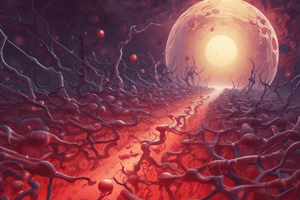Podcast
Questions and Answers
What is the primary function of platelets in hemostasis?
What is the primary function of platelets in hemostasis?
- To form a protein mesh around the platelet plug
- To anchor the vessel to surrounding tissues
- To secrete nitric oxide and prostaglandins
- To aggregate at the site of injury to form a plug (correct)
What is the purpose of fibrin in hemostasis?
What is the purpose of fibrin in hemostasis?
- To secrete nitric oxide and prostaglandins
- To expand and contract the blood vessel lumen
- To reinforce the platelet plug with collagen fibers
- To form a protein mesh around the platelet plug (correct)
What is the role of collagen fibers in hemostasis?
What is the role of collagen fibers in hemostasis?
- To secrete nitric oxide and prostaglandins
- To form a protein mesh around the platelet plug
- To reinforce the platelet plug
- To protect the vessel and anchor it to surrounding tissues (correct)
What is the primary function of smooth muscle cells in hemostasis?
What is the primary function of smooth muscle cells in hemostasis?
Why is secondary hemostasis necessary after primary hemostasis?
Why is secondary hemostasis necessary after primary hemostasis?
What is the primary function of fibrinogen in hemostasis?
What is the primary function of fibrinogen in hemostasis?
What is the role of the platelet plug in hemostasis?
What is the role of the platelet plug in hemostasis?
What is the purpose of collagen fibers in relation to the platelet plug?
What is the purpose of collagen fibers in relation to the platelet plug?
What is the primary function of secondary hemostasis?
What is the primary function of secondary hemostasis?
What is the purpose of the protein mesh formed by fibrin?
What is the purpose of the protein mesh formed by fibrin?
Flashcards
Hemostasis
Hemostasis
The process to stop blood loss after injury.
Primary Hemostasis
Primary Hemostasis
Formation of a platelet plug at the injury site.
Secondary Hemostasis
Secondary Hemostasis
Reinforcement of the platelet plug with a fibrin mesh.
Platelet Adhesion
Platelet Adhesion
Signup and view all the flashcards
Platelet Activation
Platelet Activation
Signup and view all the flashcards
Platelet Aggregation
Platelet Aggregation
Signup and view all the flashcards
Fibrin
Fibrin
Signup and view all the flashcards
Coagulation Cascade
Coagulation Cascade
Signup and view all the flashcards
Thrombin
Thrombin
Signup and view all the flashcards
Fibrinolysis
Fibrinolysis
Signup and view all the flashcards
Study Notes
Hemostasis
- The primary function of hemostasis is to prevent blood loss.
Primary Hemostasis
- Involves the formation of a platelet plug.
- The first step of primary hemostasis is adhesion, where platelets adhere to the damaged endothelium.
- The next step is activation, where platelets become activated and release chemicals.
- Aggregation is the final step, where platelets clump together to form a platelet plug.
- The 'mortar' between the 'bricks' of platelets is fibrinogen.
Secondary Hemostasis
- Involves the reinforcement of the platelet plug with a protein mesh made of fibrin.
- Fibrin is formed from fibrinogen through the coagulation cascade.
- The primary function of secondary hemostasis is to reinforce the platelet plug.
- Fibrinogen is converted to fibrin by the enzyme thrombin.
Platelet Activation
- ADP and thromboxane A2 are platelet activators.
- Prostaglandin and nitric oxide are platelet inhibitors.
- GPIIB/IIIA receptors on platelets link platelets together during hemostasis.
- The final step of platelet activation is aggregation.
Blood Vessel Structure
- The endothelium is responsible for detecting injuries and triggering vascular spasms.
- Smooth muscle cells regulate blood flow and pressure by contracting and relaxing.
- Collagen provides structural support and protection to the vessel.
- Elastic fibers allow the vessel to expand and contract.
Coagulation Cascade
- The coagulation cascade is a series of reactions that form a clot.
- Fibrin is formed from fibrinogen through the coagulation cascade.
- Thrombin is the enzyme that converts fibrinogen to fibrin.
- Antithrombin III is a natural anticoagulant that inhibits thrombin activity.
- Vitamin K is essential for the synthesis of clotting factors II, VII, IX, and X.
Fibrinolysis
- The primary function of plasmin is to degrade fibrin clots.
- Fibrinolysis is the process of breaking down fibrin clots.
Hemostasis Summary
- Primary hemostasis involves the formation of a platelet plug.
- Secondary hemostasis involves the reinforcement of the platelet plug with a protein mesh made of fibrin.
- The primary function of hemostasis is to prevent blood loss.
- The coagulation cascade is a series of reactions that form a clot.
- Fibrinolysis is the process of breaking down fibrin clots.
Studying That Suits You
Use AI to generate personalized quizzes and flashcards to suit your learning preferences.




